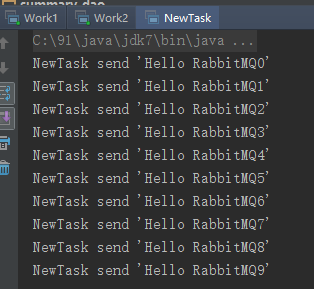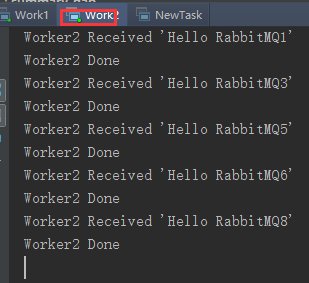初步认识rabbitmq及其编码实现
初步认识rabbitmq :
前言:在这里我将用java来简单的实现rabbitMQ。下面我们带着下面问题来一步步的了解和学习rabbitMQ。
1:如果消费者连接中断,这期间我们应该怎么办
2:如何做到负载均衡
3:如何有效的将数据发送到相关的接收者?就是怎么样过滤
4:如何保证消费者收到完整正确的数据
5:如何让优先级高的接收者先收到数据
一:"Hello RabbitMQ"
下面有一幅图,其中P表示生产者,C表示消费者,红色部分为消息队列
二:项目开始
2.1:首先引入rabbitMQ jar包
com.rabbitmq amqp-client 3.6.5
2.2:创建消费者Producer
![]()
/**
* 消息生成者
*/
public class Producer {
public final static String QUEUE_NAME="rabbitMQ.test";
public static void main(String[] args) throws IOException, TimeoutException {
//创建连接工厂
ConnectionFactory factory = new ConnectionFactory();
//设置RabbitMQ相关信息
factory.setHost("localhost");
//factory.setUsername("lp");
//factory.setPassword("");
// factory.setPort(2088);
//创建一个新的连接
Connection connection = factory.newConnection();
//创建一个通道
Channel channel = connection.createChannel();
// 声明一个队列 channel.queueDeclare(QUEUE_NAME, false, false, false, null);
String message = "Hello RabbitMQ";
//发送消息到队列中
channel.basicPublish("", QUEUE_NAME, null, message.getBytes("UTF-8"));
System.out.println("Producer Send +'" + message + "'");
//关闭通道和连接
channel.close();
connection.close();
}
}
![]()
注1:queueDeclare第一个参数表示队列名称、第二个参数为是否持久化(true表示是,队列将在服务器重启时生存)、第三个参数为是否是独占队列(创建者可以使用的私有队列,断开后自动删除)、第四个参数为当所有消费者客户端连接断开时是否自动删除队列、第五个参数为队列的其他参数
注2:basicPublish第一个参数为交换机名称、第二个参数为队列映射的路由key、第三个参数为消息的其他属性、第四个参数为发送信息的主体
2.3:创建消费者
![]()
public class Customer {
private final static String QUEUE_NAME = "rabbitMQ.test";
public static void main(String[] args) throws IOException, TimeoutException {
// 创建连接工厂
ConnectionFactory factory = new ConnectionFactory();
//设置RabbitMQ地址
factory.setHost("localhost");
//创建一个新的连接
Connection connection = factory.newConnection();
//创建一个通道
Channel channel = connection.createChannel();
//声明要关注的队列
channel.queueDeclare(QUEUE_NAME, false, false, true, null);
System.out.println("Customer Waiting Received messages");
//DefaultConsumer类实现了Consumer接口,通过传入一个频道,
// 告诉服务器我们需要那个频道的消息,如果频道中有消息,就会执行回调函数handleDelivery
Consumer consumer = new DefaultConsumer(channel) {
@Override
public void handleDelivery(String consumerTag, Envelope envelope,
AMQP.BasicProperties properties, byte[] body)
throws IOException {
String message = new String(body, "UTF-8");
System.out.println("Customer Received '" + message + "'");
}
};
//自动回复队列应答 -- RabbitMQ中的消息确认机制
channel.basicConsume(QUEUE_NAME, true, consumer);
}
![]()
前面代码我们可以看出和生成者一样的,后面的是获取生产者发送的信息,其中envelope主要存放生产者相关信息(比如交换机、路由key等)body是消息实体。
2.4:运行结果
生产者:
消费者:
三:实现任务分发
工作队列
一个队列的优点就是很容易处理并行化的工作能力,但是如果我们积累了大量的工作,我们就需要更多的工作者来处理,这里就要采用分布机制了。
我们新创建一个生产者NewTask
![]()
public class NewTask {
private static final String TASK_QUEUE_NAME="task_queue";
public static void main(String[] args) throws IOException, TimeoutException {
ConnectionFactory factory=new ConnectionFactory();
factory.setHost("localhost");
Connection connection=factory.newConnection();
Channel channel=connection.createChannel();
channel.queueDeclare(TASK_QUEUE_NAME,true,false,false,null);
//分发信息
for (int i=0;i<10;i++){
String message="Hello RabbitMQ"+i;
channel.basicPublish("",TASK_QUEUE_NAME,
MessageProperties.PERSISTENT_TEXT_PLAIN,message.getBytes());
System.out.println("NewTask send '"+message+"'");
}
channel.close();
connection.close();
}
}
![]()
然后创建2个工作者Work1和Work2代码一样
![]()
public class Work1 {
private static final String TASK_QUEUE_NAME = "task_queue";
public static void main(String[] args) throws IOException, TimeoutException {
final ConnectionFactory factory = new ConnectionFactory();
factory.setHost("localhost");
Connection connection = factory.newConnection();
final Channel channel = connection.createChannel();
channel.queueDeclare(TASK_QUEUE_NAME, true, false, false, null);
System.out.println("Worker1 Waiting for messages");
//每次从队列获取的数量
channel.basicQos(1);
final Consumer consumer = new DefaultConsumer(channel) {
@Override
public void handleDelivery(String consumerTag,
Envelope envelope,
AMQP.BasicProperties properties,
byte[] body) throws IOException {
String message = new String(body, "UTF-8");
System.out.println("Worker1 Received '" + message + "'");
try {
throw new Exception();
//doWork(message);
}catch (Exception e){
channel.abort();
}finally {
System.out.println("Worker1 Done");
channel.basicAck(envelope.getDeliveryTag(),false);
}
}
};
boolean autoAck=false;
//消息消费完成确认
channel.basicConsume(TASK_QUEUE_NAME, autoAck, consumer);
}
private static void doWork(String task) {
try {
Thread.sleep(1000); // 暂停1秒钟
} catch (InterruptedException _ignored) {
Thread.currentThread().interrupt();
}
}
}
![]()
注:channel.basicQos(1);保证一次只分发一个 。autoAck是否自动回复,如果为true的话,每次生产者只要发送信息就会从内存中删除,那么如果消费者程序异常退出,那么就无法获取数据,我们当然是不希望出现这样的情况,所以才去手动回复,每当消费者收到并处理信息然后在通知生成者。最后从队列中删除这条信息。如果消费者异常退出,如果还有其他消费者,那么就会把队列中的消息发送给其他消费者,如果没有,等消费者启动时候再次发送。
在上一篇我们都是采用发送信息到队列然后队列把信息在发送到消费者,其实实际情况并非如此,rabbitMQ其实真正的思想是生产者不发送任何信息到队列,甚至不知道信息将发送到哪个队列。相反生产者只能发送信息到交换机,交换机接收到生产者的信息,然后按照规则把它推送到对列中,交换机是如何做处理他接收到的信息,并怎么样发送到特定的队列,那么这一篇主要是讲解交换机的规则。
2. 采用不同的交换规则:
一:发布/订阅
在上一篇说到的队列都指定了名称,但是现在我们不需要这么做,我们需要所有的日志信息,而不只是其中的一个。如果要做这样的队列,我们需要2件事,一个就是获取一个新的空的队列,这样我就需要创建一个随机名称的队列,最好让服务器帮我们做出选择,第一个就是我们断开用户的队列,应该自动进行删除。ok下面是一副工作图。
![]()
信息发送端代码
![]()
public class EmitLog {
private static final String EXCHANGE_NAME = "logs";
public static void main(String[] args) throws IOException, TimeoutException {
ConnectionFactory factory=new ConnectionFactory();
factory.setHost("localhost");
Connection connection=factory.newConnection();
Channel channel=connection.createChannel();
channel.exchangeDeclare(EXCHANGE_NAME,"fanout");//fanout表示分发,所有的消费者得到同样的队列信息
//分发信息
for (int i=0;i<5;i++){
String message="Hello World"+i;
channel.basicPublish(EXCHANGE_NAME,"",null,message.getBytes());
System.out.println("EmitLog Sent '" + message + "'");
}
channel.close();
connection.close();
}
![]()
消费者代码
![]()
public class ReceiveLogs1 {
private static final String EXCHANGE_NAME = "logs";
public static void main(String[] args) throws IOException, TimeoutException {
ConnectionFactory factory = new ConnectionFactory();
factory.setHost("localhost");
Connection connection = factory.newConnection();
Channel channel = connection.createChannel();
channel.exchangeDeclare(EXCHANGE_NAME, "fanout");
//产生一个随机的队列名称
String queueName = channel.queueDeclare().getQueue();
channel.queueBind(queueName, EXCHANGE_NAME, "");//对队列进行绑定
System.out.println("ReceiveLogs1 Waiting for messages");
Consumer consumer = new DefaultConsumer(channel) {
@Override
public void handleDelivery(String consumerTag, Envelope envelope, AMQP.BasicProperties properties, byte[] body) throws IOException {
String message = new String(body, "UTF-8");
System.out.println("ReceiveLogs1 Received '" + message + "'");
}
};
channel.basicConsume(queueName, true, consumer);//队列会自动删除
}
}
![]()
上面就完成了一个发布/订阅模式的消息队列 看看结果
![]()
![]()
![]()
二:Routing
上面我用采用了广播的模式进行消息的发送,现在我们采用路由的方式对不同的消息进行过滤
![]()
发送端代码
![]()
public class RoutingSendDirect {
private static final String EXCHANGE_NAME = "direct_logs";
// 路由关键字
private static final String[] routingKeys = new String[]{"info" ,"warning", "error"};
public static void main(String[] args) throws IOException, TimeoutException {
ConnectionFactory factory = new ConnectionFactory();
factory.setHost("localhost");
Connection connection = factory.newConnection();
Channel channel = connection.createChannel();
//声明交换机
channel.exchangeDeclare(EXCHANGE_NAME,"direct");//注意是direct
//发送信息
for (String routingKey:routingKeys){
String message = "RoutingSendDirect Send the message level:" + routingKey;
channel.basicPublish(EXCHANGE_NAME,routingKey,null,message.getBytes());
System.out.println("RoutingSendDirect Send"+routingKey +"':'" + message);
}
channel.close();
connection.close();
}
}
![]()
ReceiveLogsDirect1 消费者代码
![]()
public class ReceiveLogsDirect1 {
// 交换器名称
private static final String EXCHANGE_NAME = "direct_logs";
// 路由关键字
private static final String[] routingKeys = new String[]{"info" ,"warning"};
public static void main(String[] args) throws IOException, TimeoutException {
ConnectionFactory factory = new ConnectionFactory();
factory.setHost("localhost");
Connection connection = factory.newConnection();
Channel channel = connection.createChannel();
//声明交换器
channel.exchangeDeclare(EXCHANGE_NAME, "direct");
//获取匿名队列名称
String queueName=channel.queueDeclare().getQueue();
//根据路由关键字进行绑定
for (String routingKey:routingKeys){
channel.queueBind(queueName,EXCHANGE_NAME,routingKey);
System.out.println("ReceiveLogsDirect1 exchange:"+EXCHANGE_NAME+"," +
" queue:"+queueName+", BindRoutingKey:" + routingKey);
}
System.out.println("ReceiveLogsDirect1 Waiting for messages");
Consumer consumer = new DefaultConsumer(channel) {
@Override
public void handleDelivery(String consumerTag, Envelope envelope, AMQP.BasicProperties properties, byte[] body) throws IOException {
String message = new String(body, "UTF-8");
System.out.println("ReceiveLogsDirect1 Received '" + envelope.getRoutingKey() + "':'" + message + "'");
}
};
channel.basicConsume(queueName, true, consumer);
}
![]()
ReceiveLogsDirect2消费者代码
![]()
public class ReceiveLogsDirect2 {
// 交换器名称
private static final String EXCHANGE_NAME = "direct_logs";
// 路由关键字
private static final String[] routingKeys = new String[]{"error"};
public static void main(String[] argv) throws Exception {
ConnectionFactory factory = new ConnectionFactory();
factory.setHost("localhost");
Connection connection = factory.newConnection();
Channel channel = connection.createChannel();
//声明交换器
channel.exchangeDeclare(EXCHANGE_NAME, "direct");
//获取匿名队列名称
String queueName = channel.queueDeclare().getQueue();
//根据路由关键字进行多重绑定
for (String severity : routingKeys) {
channel.queueBind(queueName, EXCHANGE_NAME, severity);
System.out.println("ReceiveLogsDirect2 exchange:"+EXCHANGE_NAME+", queue:"+queueName+", BindRoutingKey:" + severity);
}
System.out.println("ReceiveLogsDirect2 Waiting for messages");
Consumer consumer = new DefaultConsumer(channel) {
@Override
public void handleDelivery(String consumerTag, Envelope envelope, AMQP.BasicProperties properties, byte[] body) throws UnsupportedEncodingException {
String message = new String(body, "UTF-8");
System.out.println("ReceiveLogsDirect2 Received '" + envelope.getRoutingKey() + "':'" + message + "'");
}
};
channel.basicConsume(queueName, true, consumer);
}
}
![]()
上面代码可以看出这里是通过路由来找个这个对列的。我们看下结果
![]()
![]()
![]()
三:Topics
这种应该属于模糊匹配
* :可以替代一个词
#:可以替代0或者更多的词
现在我们继续看看代码来理解
发送端
![]()
public class TopicSend {
private static final String EXCHANGE_NAME = "topic_logs";
public static void main(String[] args) throws IOException, TimeoutException {
Connection connection = null;
Channel channel = null;
try{
ConnectionFactory factory=new ConnectionFactory();
factory.setHost("localhost");
connection=factory.newConnection();
channel=connection.createChannel();
//声明一个匹配模式的交换机
channel.exchangeDeclare(EXCHANGE_NAME,"topic");
//待发送的消息
String[] routingKeys=new String[]{
"quick.orange.rabbit",
"lazy.orange.elephant",
"quick.orange.fox",
"lazy.brown.fox",
"quick.brown.fox",
"quick.orange.male.rabbit",
"lazy.orange.male.rabbit"
};
//发送消息
for(String severity :routingKeys){
String message = "From "+severity+" routingKey' s message!";
channel.basicPublish(EXCHANGE_NAME, severity, null, message.getBytes());
System.out.println("TopicSend Sent '" + severity + "':'" + message + "'");
}
}catch (Exception e){
e.printStackTrace();
if (connection!=null){
channel.close();
connection.close();
}
}finally {
if (connection!=null){
channel.close();
connection.close();
}
}
}
}
![]()
消费者1:
![]()
public class ReceiveLogsTopic1 {
private static final String EXCHANGE_NAME = "topic_logs";
public static void main(String[] args) throws IOException, TimeoutException {
ConnectionFactory factory = new ConnectionFactory();
factory.setHost("localhost");
Connection connection = factory.newConnection();
Channel channel = connection.createChannel();
//声明一个匹配模式的交换机
channel.exchangeDeclare(EXCHANGE_NAME, "topic");
String queueName = channel.queueDeclare().getQueue();
//路由关键字
String[] routingKeys = new String[]{"*.orange.*"};
//绑定路由
for (String routingKey : routingKeys) {
channel.queueBind(queueName, EXCHANGE_NAME, routingKey);
System.out.println("ReceiveLogsTopic1 exchange:" + EXCHANGE_NAME + ", queue:" + queueName + ", BindRoutingKey:" + routingKey);
}
System.out.println("ReceiveLogsTopic1 Waiting for messages");
Consumer consumer = new DefaultConsumer(channel) {
@Override
public void handleDelivery(String consumerTag, Envelope envelope, AMQP.BasicProperties properties, byte[] body) throws IOException {
String message = new String(body, "UTF-8");
System.out.println("ReceiveLogsTopic1 Received '" + envelope.getRoutingKey() + "':'" + message + "'");
}
};
channel.basicConsume(queueName, true, consumer);
}
}
![]()
消费者2:
![]()
ublic class ReceiveLogsTopic2 {
private static final String EXCHANGE_NAME = "topic_logs";
public static void main(String[] argv) throws IOException, TimeoutException {
ConnectionFactory factory = new ConnectionFactory();
factory.setHost("localhost");
Connection connection = factory.newConnection();
Channel channel = connection.createChannel();
// 声明一个匹配模式的交换器
channel.exchangeDeclare(EXCHANGE_NAME, "topic");
String queueName = channel.queueDeclare().getQueue();
// 路由关键字
String[] routingKeys = new String[]{"*.*.rabbit", "lazy.#"};
// 绑定路由关键字
for (String bindingKey : routingKeys) {
channel.queueBind(queueName, EXCHANGE_NAME, bindingKey);
System.out.println("ReceiveLogsTopic2 exchange:"+EXCHANGE_NAME+", queue:"+queueName+", BindRoutingKey:" + bindingKey);
}
System.out.println("ReceiveLogsTopic2 Waiting for messages");
Consumer consumer = new DefaultConsumer(channel) {
@Override
public void handleDelivery(String consumerTag, Envelope envelope, AMQP.BasicProperties properties, byte[] body) throws UnsupportedEncodingException {
String message = new String(body, "UTF-8");
System.out.println("ReceiveLogsTopic2 Received '" + envelope.getRoutingKey() + "':'" + message + "'");
}
};
channel.basicConsume(queueName, true, consumer);
}
}
![]()
运行后结果
![]()
![]()
![]()
转载自 :https://www.cnblogs.com/LipeiNet/p/5977028.html
https://www.cnblogs.com/LipeiNet/p/5978276.html






